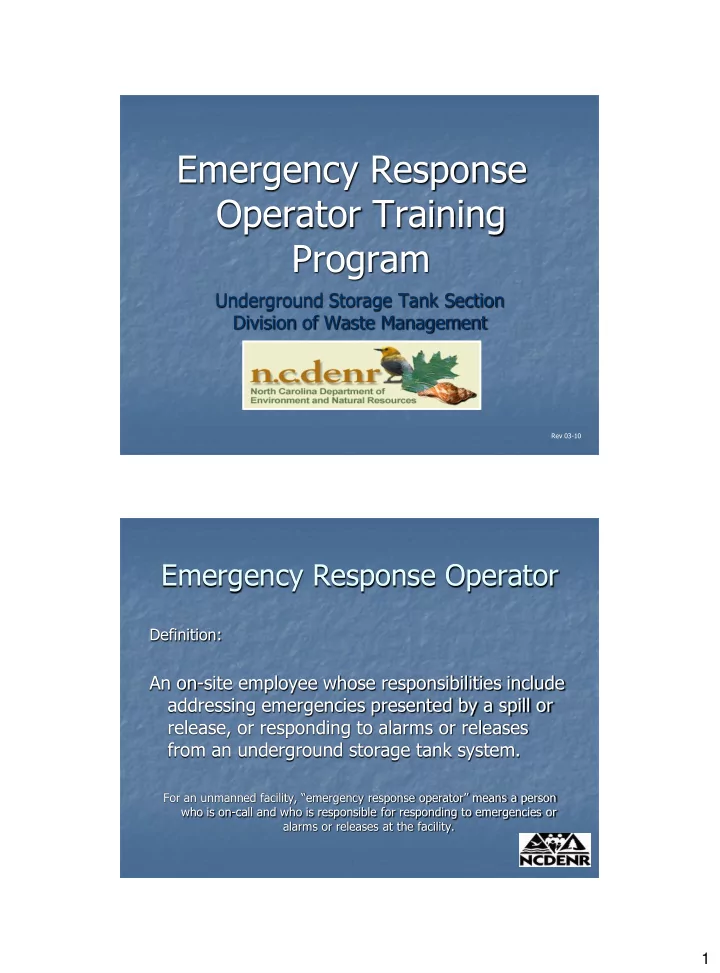

Emergency Response Operator Training Program Underground Storage Tank Section Division of Waste Management Rev 03-10 Emergency Response Operator Definition: An on-site employee whose responsibilities include addressing emergencies presented by a spill or release, or responding to alarms or releases from an underground storage tank system. For an unmanned facility, “emergency response operator” means a person who is on-call and who is responsible for responding to emergencies or alarms or releases at the facility. 1
Emergency Response Operator Designated and trained by the primary operator. Must have at least one on-site during all hours of UST system operation. Unmanned UST facilities must have an automatic notification system in place that will immediately alert the emergency response operator of an emergency or alarm or release at the facility at any time. Facility Overview Become familiar with all equipment associated with the UST systems and dispensers at your facility 2
Before a Release Know where emergency telephone numbers are posted at your facility Unmanned vehicle fueling facilities must have emergency telephone numbers located in the area of the dispensers. Know location and proper operation of all safety and emergency response equipment: Fire extinguisher Spill kit Emergency pump shutoff switch: Must be located between 20- 100 feet from the fuel dispensers, manually resettable only, and distinctly labeled as EMERGENCY FUEL SHUTOFF. Before a Release Know location of tank monitor (if applicable) and Be able to recognize warning signs and be fully prepared to respond to releases before they occur 3
Suspected Release The following are considered suspected releases: Leak detection alarms and/or failures Unusual operating conditions Environmental conditions Contact the primary operator immediately Leak Detection Alarms Automatic Tank Gauge (ATG) console shows status, warnings, and alarms 4
Leak Detection Alarms Status: Green light, indicates ATG is powered on Warnings: Yellow light, indicates non-critical problems Inform primary operator Alarms: Red light and/or audible signal Contact primary operator immediately Leak Detection Alarms Electronic Line Leak Detectors (ELLD) Failed detector or leak will result in an alarm on the monitoring console Electronic sump sensors Monitoring console will alarm when sensor detects liquid 5
Leak Detection Failures Automatic Tank Gauge (ATG) test reveals Fail, Increase or Decrease Leak Detection Failures Interstitial monitoring test reveals a Release or Alarm 6
Unusual Operating Conditions Erratic behavior of dispensing equipment Automatic Line Leak Detectors (ALLDs) may cause fuel to flow slowly at nozzle or shut off submersible pumps when a release is detected Unexplained presence of water in tanks Unusual Operating Conditions Fuel in containment sumps or interstitial spaces 7
Unusual Operating Conditions Degradation of any equipment or element of UST system to the point where it can not perform its intended function Flexible piping that has split Unusual Operating Conditions Broken spill bucket 8
Environmental Conditions Stained soil Staining around dispensers and/or fill ports Environmental Conditions Dead grass around fill port 9
Possible Causes of a Release Delivery hose disconnected from tank fill pipe Nozzle removed from dispenser Puncture of tanks, piping, or spill containment Loose fittings Broken components Overfills Corrosion Confirmed Release Take immediate action to stop further release Hit emergency shutoff switch Turn off power to dispenser and bag nozzle Contact local fire or emergency response authority if conditions warrant Contact the primary operator Identify any vapor or fire hazards to ensure the spill or leak poses no immediate hazard to human health or safety 10
Confirmed Release Sensitive receptor: Any place a fuel spill may leave your facility and enter the environment Ex. Storm drains, curb breaks, etc. Stop and contain spill BEFORE it reaches the environment Spill Kits Clean spills 5 gallons or less Contain larger spills until assistance arrives Suggested equipment: personal protective equipment (PPE) absorbent material (kitty litter, sand, sawdust, etc.) shovel, broom, bucket, booms, pads caution tape, traffic cones 11
Review Many spills and releases occur when the primary operator is not present Know your facilities emergency response plan BEFORE a release occurs Contact emergency response authority and primary operator immediately when a release is suspected or confirmed Take proper measures to stop further release and to contain spills Training must be documented on the log provided (UST-26). The Department will verify this documentation during compliance inspections. 12
Recommend
More recommend